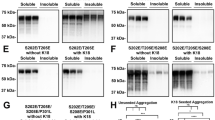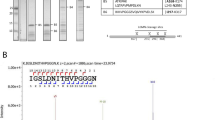Abstract
Tau-like immunoreactivity (IR) on glial cytoplasmic inclusions (GCIs) of multiple system atrophy (MSA) was investigated with a panel of anti-tau antibodies and we found that tau2, one of the phosphorylation-independent antibodies, preferentially immunolabeled GCIs. Co-presence (0.03%) of polyethyleneglycol-p-isooctylphenyl ether (Triton X-100, TX) with tau2, however, abolished this IR on GCIs, but did not abolish tau2 IR on neurofibrillary tangles (NFTs). Tau2-immmunoreactive bands on immunoblot of brain homogenates from MSA brains were retrieved mainly in a TRIS-saline-soluble fraction, as reported in normal brains. This was in contrast to SDS-soluble fractions from brain with Down's syndrome, which contained tau2-immuoreactive bands of higher molecular weight. It indicates that the appearance of tau2 IR on GCIs is not related to hyperphosphorylation of tau. These tau2-immunoreactive bands, except those from bovine brain, were similarly abolished in the presence of TX (0.06%), and repeated washing after exposure to TX restored the tau2 IR on immunohistochemistry and on immunoblot. These findings can be explained if the modified tau2 epitope undergoes a reversible conformational change on exposure to TX, which is reversible after washing. Because the conformation centered at Ser101 of bovine tau is crucial for its affinity to tau2, the Ser-like conformation mimicked by its human counterpart Pro may represent pathological modification of tau shared by GCIs and NFTs. The relative resistance of tau2 epitope on NFTs on exposure to TX suggests that tau woven into NFTs confers additional stability to the pathological conformation of tau2 epitope. The conformation of the tau2 epitope in GCIs is not as stable as in NFTs, suggesting that tau proteins are not the principal constituents of the fibrillary structures of GCIs, even though they were immunodecorated with tau2. The difference in the susceptibility of the tau2 epitope to TX may distinguish its conformational states, which are variously represented according to disease conditions.

Similar content being viewed by others
References
Abe H, Yagishita S, Amano N, Iwabuchi K, Hasegawa K, Kowa K (1992) Argyrophilic glial intracytoplasmic inclusions in multiple system atrophy: immunocytochemical and ultrastructural study. Acta Neuropathol 84:273–277
Arai N, Nishimura M, Oda M, Morimatsu Y, Oue R (1991) Immunohistochemical study of glial cytoplasmic inclusion in multiple system atrophy. No To Shinkei 43:857–862
Arai T, Ikeda K, Akiyama H, Tsuchiya K, Yagishita S, Takamatsu J (2001) Intracellular processing of aggregated tau differs between corticobasal degeneration and progressive supranuclear palsy. Neuroreport 12:935–938
Arima K, Hirai S, Sunohara N, Aoto K, Izumiyama Y, Ueda K, Ikeda K, Kawai M (1999) Cellular co-localization of phosphorylated tau- and NACP/alpha-synuclein-epitopes in Lewy bodies in sporadic Parkinson's disease and in dementia with Lewy bodies. Brain Res 843:53–61
Arima K, Ueda K, Sunohara N, Arakawa K, Hirai S, Nakamura M, Tonozuka-Uehara H, Kawai M (1998) NACP/alpha-synuclein immunoreactivity in fibrillary components of neuronal and oligodendroglia cytoplasmic inclusions in the pontine nuclei in multiple system atrophy. Acta Neuropathol 96:439–444
Arima K, Mizutani T, Alim M A, Tonozuka-Uehara H, Izumiyama Y, Hirai S, Ueda K (2000) NACP/alpha-synuclein and tau constitute two distinctive subsets of filaments in the same neuronal inclusions in brains from a family of parkinsonism and dementia with Lewy bodies: double-immunolabeling fluorescence and electron microscopic studies. Acta Neuropathol 100:115–121
Benzing WC, Mufson EJ (1995) Apolipoprotein E immunoreactivity within neurofibrillary tangles:relationship to tau and PHF in Alzheimer's disease. Exp Neurol 132:162–171
Cairns NJ, Atkinson PF, Hanger DP, Anderton BH, Daniel SE, Lantos PL (1997) Tau protein in the glial cytoplasmic inclusions of multiple system atrophy can be distinguished from abnormal tau in Alzheimer's disease. Neurosci Lett 230:49–52
Endoh R, Ogawara M, Iwatsubo T, Nakano I, Mori H (1993) Lack of the carboxyl terminal sequence of tau in ghost tangles of Alzheimer's disease. Brain Res 601:164–172
Forno LS, Langston JW, Herrick MK, Wilson JD, Murayama S (2002) Ubiquitin-positive neuronal and tau2-positive glial inclusions in frontotemporal dementia of motor neuron type. Acta Neuropathol 130:599–606
Graham JG, Oppenheimer DR (1969) Orthostatic hypertension and nicotinic sensitivity in a case of multiple system atrophy. J Neurol Neurosurg Psychiatry 32:28–34
Ishiyama M, Yagishita S, Shibuya K (2002) On ultrastructural immunocyochemistry (nanogold prove method) to the tissue of the central nervous system formalin-fixed for 5 years: Tau-2 immunostaining in a case of MSA. Neuropathology 22 (Suppl):A29
Kato S, Nakamura H, Hirano A, Ito H, Llena JF, Yen SH (1991) Argyrophilic ubiquitinated cytoplasmic inclusions of Leu-7-positive glial cells in olivopontocerebellar atrophy (multiple system atrophy) Acta Neuropathol 82:488–493
Kertesz A, Kawarai T, Rogaeva E, St. George-Hyslop P, Poorkaj P, Bird TD, Munoz DG (2000) Familial frontotemporal dementia with ubiquitin-positive, tau-negative inclusions. Neurology 54:818–827
Kobayashi K, Miyazu K, Katsukawa K, Fukutani Y, Mukai M, Nakamura I, Yamaguchi N, Matsubara R, Isaki K (1992) Cytoskeletal protein abnormalities in patients with olivopontocerebellar atrophy—an immunocytochemical and Gallyas silver impregnation study. Neuropathol Appl Neurobiol 18:237–249
Matsuo ES, Shin R-W, Billingsley ML, Van deVoorde A, O'Connor M, Trojanowski JQ, Lee VM-Y (1994) Biopsy-derived adult human brain tau is phosphorylated at many of the same sites as Alzheimer's disease paired helical filament tau. Neuron 13:989–1002
Mercken M, Vandermeeren M, Lübke U, Six J, Boons J, Van de Voorde A, Martin JJ, Gheuens J (1992) Monoclonal antibodies with selective specificity for Alzheimer tau are directed against phophatase-sensitive epitopes. Acta Neuropathol 84:265–272
Murayama S, Arima K, Nakazato Y, Satoh J, Oda M, Inose T (1992) Immunocytochemical and ultrastructural studies of neuronal and oligodendroglial cytoplasmic inclusions in multiple system atrophy. 2. Oligodendroglial cytoplasmic inclusions. Acta Neuropathol 84:32–38
Nakazato Y, Yamazaki H, Hirato J, Ishida Y, Yamaguchi H (1990) Oligodendroglial microtubular tangles in olivopontocerebellar atrophy. J Neuropathol Exp Neurol 49:521–530
Odawara T, Iseki E, Kosaka K, Akiyama H, Ikeda K, Yamamoto T (1995) Investigation of tau-2 positive microglia-like cells in the subcortical nuclei of human neurodegenerative disorders. Neurosci Lett 192:145–148
Papasozomenos SC (1989) Tau protein immunoreactivity in dementia of the Alzheimer type I. Morphology, evolution, distribution, and pathogenetic implications. Lab Invest 60:123–137
Papasozomenos SC, Binder LI (1987) Phosphorylation determines two distinct species of tau in the central nervous system. Cell Motil Cytoskel 8:210–226
Papp MI, Lantos PL (1992) Accumulation of tubular structures in oligodendroglial and neuronal cells as the basic alteration in multiple system atrophy. J Neurol Sci 107:172–182
Papp MI, Kahn JE, Lantos PL (1989) Glial cytoplasmic inclusions in the CNS of patients with multiple system atrophy (striatonigral degeneration, olivopontocerebellar atrophy and Shy-Drager syndrome). J Neurol Sci 94:79–100
Piao YS, Hayashi S, Hasegawa M, Wakabayashi K, Yamada M, Yoshimoto M, Ishikawa A, Iwatsubo T, Takahashi H (2001) Co-localization of alpha-synuclein and phosphorylated tau in neuronal and glial cytoplasmic inclusions in a patient with multiple system atrophy of long duration. Acta Neuropathol 101:285–293
Pollock NJ, Wood JG (1988) Differential sensitivity of the microtubule associated protein, tau, in Alzheimer's disease tissue to formalin fixation. J Histochem Cytochem 36:1117–1121
Probst-Cousin S, Bergmann M, Kuchelmeister K, Schröder R, Schmid KW (1996) Ubiquitin-positive inclusions in different types of multiple system atrophy: distribution and specificity. Pathol Res Pract 192:453–461
Reusche E, Ogomori K, Diebold J, Johannisson R (1992) Electron microscopic study of paired helical filaments and cereberal amyloid using a novel en bloc silver staining method. Virchows Arch 420:519–525
Takeda A, Arai N, Komori T, Iseki E, Kato S, Oda M (1997) Tau immunoreactivity in glial cytoplasmic inclusions in multiple system atrophy. Neurosci Lett 234:63–66
Takeda A, Hisamoto M, Mallory M, Sundsumo M, Hansen L, Masliah E (2000) C-terminal α-synuclein immunoreactivity in structures other than Lewy bodies in neurodegenerative disorders. Acta Neuropathol 99:296–304
Tamaoka A, Mizusawa H, Mori H, Shoji S (1995) Ubiquitinated alpha B-crystallin in glial cytoplasmic inclusions from the brain of a patient with multiple system atrophy. J Neurol Sci 129:192–198
Tu PH, Galvin JE, Baba M, Giasson B, Tomita T, Leight S, Nakajo S, Iwatsubo T, Trojanowski JQ, Lee VM (1998) Glial cytoplasmic inclusions in white matter oligodendrocytes of multiple system atrophy brains contain insoluble alpha-synuclein. Ann Neurol 44:415–422
Uchihara T, Tsuchiya K, Kondo H, Hayama T, Ikeda K (1995) Widespread appearance of Alz-50 immunoreactive neurons in the human brain with cerebral infarction. Stroke 26:2145–2148
Uchihara T, Tsuchiya K, Nakamura A, Ikeda K (2000) Appearance of tau-2 immunoreactivity in glial cells in human brain with cerebral infarction. Neurosci Lett 286:99–102
Uchihara T, Nakamura A, Arai T, Ikeda K, Tsuchiya K (2002) Reversible conformational change of tau2 epitope exposed to detergent. Neuropathology 22 (Suppl):A22
Wakabayashi K, Yoshimoto M, Tsuji S, Takahashi H (1998) Alpha-synuclein immunoreactivity in glial cytoplasmic inclusions in multiple system atrophy. Neurosci Lett 249:180–182
Watanabe N, Takio K, Hasegawa M, Arai T, Titani K, Ihara Y (1992) Tau 2: a probe for a Ser conformation in the amino terminus of tau, J Neurochem 58:960–966
Wolozin BL, Pruchnicki A, Dickson DW, Davies P (1986) A neuronal antigen in the brains of Alzheimer's patients. Science 232:648–650
Author information
Authors and Affiliations
Corresponding author
Rights and permissions
About this article
Cite this article
Shibuya, K., Uchihara, T., Nakamura, A. et al. Reversible conformational change of tau2 epitope on exposure to detergent in glial cytoplasmic inclusions of multiple system atrophy. Acta Neuropathol 105, 508–514 (2003). https://doi.org/10.1007/s00401-003-0675-4
Received:
Revised:
Accepted:
Published:
Issue Date:
DOI: https://doi.org/10.1007/s00401-003-0675-4




